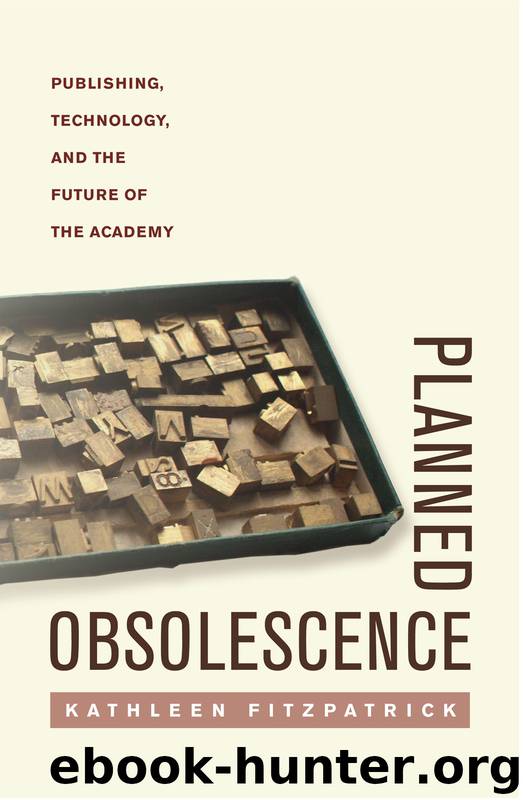Planned Obsolescence by Fitzpatrick Kathleen;

Author:Fitzpatrick, Kathleen;
Language: eng
Format: epub
Publisher: NYU Press
Published: 2011-03-13T05:00:00+00:00
Standards
One of the first issues we must consider in thinking about the durability of digital texts is the format in which those texts are produced and encoded. A format that adheres to commonly agreed-upon standards can enable long-term access to the text, while one that uses a nonstandard protocol can create difficulties. This is not to say that all texts must or even should conform to the same structures and formats; any text contains its own peculiarities, and the possibilities presented by digital publishing only expand the range of potential forms and formats. But certain kinds of standardization are helpful for ensuring that a text is at least commonly readable across as many platforms as possible, and for as long as possible.
We employ standards in this way across our lives, where they often appear wholly naturalized but in fact represent the imposition of certain kinds of socially determined regulations that provide us with a stable and reliable experience of the phenomenon in question; the electrical system that provides power to our homes and offices, for instance, does so through a set of standards for voltages and interfaces, and nearly anyone who has traveled abroad can testify to the problems that can result from using an appliance that does not conform to the local standards. Even time itself had to be standardized; the development of phenomena such as time zones didn’t take place until the spread of the railroads demanded a commonly accepted schedule. Textual standards exist for many of the same reasons, making nearly any given newspaper, journal, or book we pick up, from any publisher in any city, instantly comprehensible to us (at least in format, if not in the particulars of its content). The phenomena that operate all but invisibly to make the pages of a book readable to us today, including spacing between words, punctuation, regularized spelling, paragraphing, page numbers and headers, tables of contents, and so forth, took centuries to develop. Digital texts, by contrast, proliferated quickly, and their producers were concerned enough about sharing them that the problem of standards arose quite early in their lifespan.
Certain kinds of standards have long been available in web publishing; standards for HyperText Markup Language (HTML), for instance, are developed by the World Wide Web Consortium (W3C), which under the direction of World Wide Web inventor Tim Berners-Lee issues protocols and guidelines designed to ensure robust web interoperability. Such “vendor-neutral” interoperability ensures, among other things, that web pages are and will remain interpretable by any major browser.6 As Nick Montfort and Noah Wardrip-Fruin (2004) advise authors of electronic literature, “Validating a page or site, using a service like the W3C Validator or the validator built into BBEdit, ensures that all browsers that comply with World Wide Web Consortium standards, now and in the future, will deal with the page correctly.” This is not to say that HTML hasn’t changed over time, or that browsers are somehow required to conform to the W3C’s recommendations, but the web’s general stability is
Download
This site does not store any files on its server. We only index and link to content provided by other sites. Please contact the content providers to delete copyright contents if any and email us, we'll remove relevant links or contents immediately.
| Anthropology | Archaeology |
| Philosophy | Politics & Government |
| Social Sciences | Sociology |
| Women's Studies |
The Leavers by Lisa Ko(6474)
Born to Run: by Christopher McDougall(6263)
iGen by Jean M. Twenge(4702)
Sapiens by Yuval Noah Harari(4537)
The Kite Runner by Khaled Hosseini(4438)
Spare by Prince Harry The Duke of Sussex(4199)
Bullshit Jobs by David Graeber(3180)
Livewired by David Eagleman(3123)
Goodbye Paradise(2964)
Never by Ken Follett(2884)
A Dictionary of Sociology by Unknown(2518)
Harry Potter 4 - Harry Potter and The Goblet of Fire by J.K.Rowling(2416)
The Club by A.L. Brooks(2361)
People of the Earth: An Introduction to World Prehistory by Dr. Brian Fagan & Nadia Durrani(2346)
The Social Psychology of Inequality by Unknown(2311)
Machine Learning at Scale with H2O by Gregory Keys | David Whiting(2293)
Harry Potter and the Order of the Phoenix (5) by J.K. Rowling(2227)
0041152001443424520 .pdf by Unknown(2220)
Don't Sleep, There Are Snakes by Daniel L. Everett(2217)
